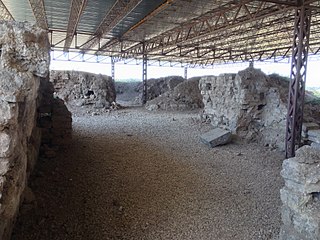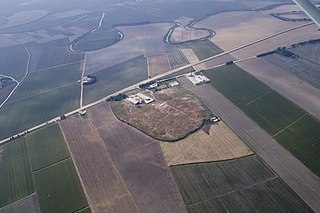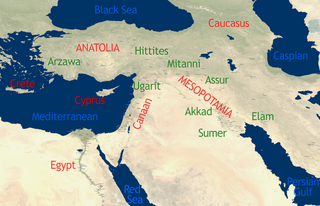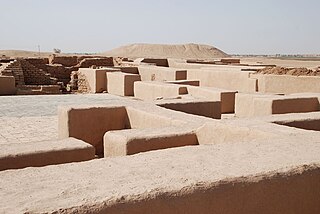Related Research Articles

The Hurrians were a people who inhabited the Ancient Near East during the Bronze Age. They spoke the Hurrian language, and lived throughout northern Syria, upper Mesopotamia and southeastern Anatolia.

Mitanni, earlier called Ḫabigalbat in old Babylonian texts, c. 1600 BC; Hanigalbat or Hani-Rabbat in Assyrian records, or Naharin in Egyptian texts, was a Hurrian-speaking state in northern Syria and southeast Anatolia with Indo-Aryan linguistic and political influences. Since no histories, royal annals or chronicles have yet been found in its excavated sites, knowledge about Mitanni is sparse compared to the other powers in the area, and dependent on what its neighbours commented in their texts.

Alalakh is an ancient archaeological site approximately 20 kilometres (12 mi) northeast of Antakya in what is now Turkey's Hatay Province. It flourished, as an urban settlement, in the Middle and Late Bronze Age, c. 2000-1200 BC. The city contained palaces, temples, private houses and fortifications. The remains of Alalakh have formed an extensive mound covering around 22 hectares. In the Late Bronze Age, Alalakh was the capital of the local kingdom of Mukiš.

Waššukanni or Aššukanni was the capital of the Hurrian kingdom of Mitanni, from around 1500 BC to the 13th century BC.

Aššur (; Sumerian: 𒀭𒊹𒆠 AN.ŠAR2KI, Assyrian cuneiform: Aš-šurKI, "City of God Aššur"; Syriac: ܐܫܘܪ Āšūr; Old Persian: 𐎠𐎰𐎢𐎼 Aθur, Persian: آشور Āšūr; Hebrew: אַשּׁוּר ʾAššūr, Arabic: اشور), also known as Ashur and Qal'at Sherqat, was the capital of the Old Assyrian city-state (2025–1364 BC), the Middle Assyrian Empire (1363–912 BC), and for a time, of the Neo-Assyrian Empire (911–609 BC). The remains of the city lie on the western bank of the Tigris River, north of the confluence with its tributary, the Little Zab, in what is now Iraq, more precisely in the al-Shirqat District of the Saladin Governorate.
Tushhan was a Neo-Assyrian provincial capital in the upper Tigris region. It was rebuilt by the ruler Ashurnasirpal II and survived until the end of the Neo-Assyrian period around 611 BC.

Tell Ta'yinat is a low-lying ancient tell on the east bank at the bend of the Orontes River where it flows through the Amuq valley, in the Hatay province of southeastern Turkey about 25 kilometers south east of Antakya, and lies near Tell Atchana, the site of the ancient city of Alalakh. Tell Ta'yinat has been proposed as the site of Alalaḫu, inhabited in late 3rd millennium BC, mentioned in Ebla's Palace G archive; and in later times as Kinalua, the capital city of an Iron Age Neo-Hittite kingdom. Among the findings are an Iron Age temple and several 1st millennium BC cuneiform tablets. Chatal Huyuk (Amuq) is another major site that is located in the area.

Tell Halaf is an archaeological site in the Al Hasakah governorate of northeastern Syria, a few kilometers from the city of Ras al-Ayn near the Syria–Turkey border. The site, which dates to the sixth millennium BCE, was the first to be excavated from a Neolithic culture, later called the Halaf culture, characterized by glazed pottery painted with geometric and animal designs.

Tell Barri is a tell, or archaeological settlement mound, in north-eastern Syria in the Al-Hasakah Governorate. Its ancient name was Kahat as proven by a threshold found on the south-western slope of the mound. Tell Barri is situated along the Wadi Jaghjagh, a tributary of the Khabur River.

Tell Fekheriye is an ancient site in the Khabur river basin in al-Hasakah Governorate of northern Syria. It is securely identified as the site of Sikkan, attested since c. 2000 BC. While under an Assyrian governor c. 1000 BC it was called Sikani. Sikkan was part of the Syro-Hittite state of Bit Bahiani in the early 1st millennium BC. In the area, several mounds, called tells, can be found in close proximity: Tell Fekheriye, Ras al-Ayn, and 2.5 kilometers east of Tell Halaf, site of the Aramean and Neo-Assyrian city of Guzana. During the excavation, the Tell Fekheriye bilingual inscription was discovered at the site, which provides the source of information about Hadad-yith'i.

The Civilization of Mesopotamia ranges from the earliest human occupation in the Paleolithic period up to Late antiquity. This history is pieced together from evidence retrieved from archaeological excavations and, after the introduction of writing in the late 4th millennium BC, an increasing amount of historical sources. While in the Paleolithic and early Neolithic periods only parts of Upper Mesopotamia were occupied, the southern alluvium was settled during the late Neolithic period. Mesopotamia has been home to many of the oldest major civilizations, entering history from the Early Bronze Age, for which reason it is often called a cradle of civilization.

Ekallatum (Akkadian: 𒌷𒂍𒃲𒈨𒌍, URUE2.GAL.MEŠ, Ekallātum, "the Palaces") was an ancient Amorite city-state and kingdom in upper Mesopotamia.

Kurda was an ancient city-state and a Middle Bronze petty kingdom located in the region of the Sinjar Plain in Northern Mesopotamia. It is mentioned along with Andarig and Apum.

The chronology of the ancient Near East is a framework of dates for various events, rulers and dynasties. Historical inscriptions and texts customarily record events in terms of a succession of officials or rulers: "in the year X of king Y". Comparing many records pieces together a relative chronology relating dates in cities over a wide area.
Tell al-Fakhar is a tell, or archaeological settlement mound, 45 kilometers southwest of the modern city of Kirkuk in Kirkuk Governorate, northeastern Iraq. Excavations revealed two occupation phases that were dated to the Mitanni/Kassite and Neo-Assyrian periods, or mid-second and early-first millennia BCE. The mid-second millennium phase consisted of a large building, dubbed the "Green Palace", where an archive of circa 800 clay tablets was found. It has been suggested that the site's name was Kurruḫanni but later researchers have called this into question.

Tell Sheikh Hamad, also Dur-Katlimmu, is an archeological site in eastern Syria on the lower Khabur River, a tributary of the Euphrates.
Tall Bazi, is an ancient Near East archaeological site in Raqqa Governorate of Syria in the same general area as Mari and Ebla. It is located on the east bank of Euphrates river in upper Syria, about 60 kilometers south of Turkey border. It is considered a twin site to the adjacent Tell Banat Complex. Both were occupied in the 3rd and 2nd millennium BC with Banat being the focus in the early part and Bazi in the later. Tall Bazi has been proposed as the location of Armanum, known from texts of Sargon and Naram-Sin in the Akkadian period, during the reign of Naram-Sin of Akkad. It was occupied into the Mitanni period, with an occupational gap after c. 2300 BC, at which time it was destroyed. In the Late Roman Empire a large building was constructed at the top of the main mound, using the remaining Late Bronze Age fortification walls.
Kurd Qaburstan, is an ancient Near East archaeological site in the Erbil Governorate, in the Kurdistan Region of Iraq, 22 kilometers southwest of Erbil. It is considered one of the most important archaeological sites in the region. The site is strategically located between the Upper and Lower Zab rivers. The modern village of Yedi Kizlar is adjacent to and covers a portion of the southeastern lower town. The site is primarily a single-period site dating to the early 2nd millennium BC, the Middle Bronze Age. There is also a compact Late Bronze Age occupation on the high mound. Kurd Qaburstan has been proposed as the location of the ancient city of Qabra. The site is located near Tell Halawa, Tell Aliawa, Tell Baqrta, and Qasr Shemamok (Kilizi), other prominent sites on the Erbil plain.
Tall Al-Hamidiya is an ancient Near Eastern archeological site the upper Hābūr region of modern-day Syria in the Al-Hasakah Governorate on a loop of the Jaghjagh River. It is located just to the north of the site of Tell Barri, just to the east of the ancient site of Tell Arbid, just to the west of Tell Farfara and 20 kilometers north of Tell Brak. It has been suggested as the location of Ta'idu/Taite. If so, it was mentioned as Ta'idu in early 2nd millennium BC Ebla and Mari texts. Later it was a provincial capital of the Middle Bronze Age Mitanni Empire. This identification is based primarily on a few Middle Assyrian Neo-Assyrian sources, as Taite, and the proximity of Kahat, known to have been nearby. Other locations have been proposed for Ta'idu/Taite.
Üçtepe Höyük, is an ancient Near East archaeological site in Diyarbakır Province, Turkey about 40 kilometers southeast of the modern city of Diyarbakır and about 10 kilometers southwest of modern Bismil. The village of Üçtepe is nearby. It was occupied from the Late Early Bronze Age until the Roman period and is notable as the discovery location of the Kurkh Monoliths. The ancient site of Ziyaret Tepe lies 22 kilometers to the west. Other archaeological sites in the area include Pir Hüseyin, Kenan Tepe, Hirbemerdon Tepe, Salat Tepe, Giricano, and Sahin Tepe.
References
- ↑ Wäfler, Markus, "Tall al-Hamïdïya: Ta'idu", HASBonline–Hefte zur Archäologie des Mittelmeerraumes aus Bern 20, 33-58, 2007
- ↑ Berthon, Rémi, "Small but Varied: The Role of Rural Settlements in the Diversification of Subsistence Practices as Evidenced in the Upper Tigris River Area (Southeastern Turkey) during the Second and First Millennia BCE", Journal of Eastern Mediterranean Archaeology & Heritage Studies, vol. 2, no. 4, pp. 317–29, 2014
- ↑ Buccellati, Federico, "Learning New Styles, Quickly: An Examination of the Mittani–Middle Assyrian Transition in Material Culture", Values and Revaluations: The Transformation and Genesis of “Values in Things” from Archaeological and Anthropological Perspectives, edited by Hans Peter Hahn et al., Oxbow Books, pp. 29–46, 2022
- ↑ Hendrik Hameeuw, "1947: Two tablets as a Christmas gift to a Leuven Assyriologist", in Ancient Near East, a life! Festschrift Karel Van Lerberghe edited by Tom Boiy et al, Katholieke Universiteit Leuven, 2012
- ↑ Thames, John Tracy, "International Politics and Local Change at Emar in the Late Bronze Age" ,Journal of Ancient Near Eastern History, vol. 10, no. 1, pp. 23-52, 2023